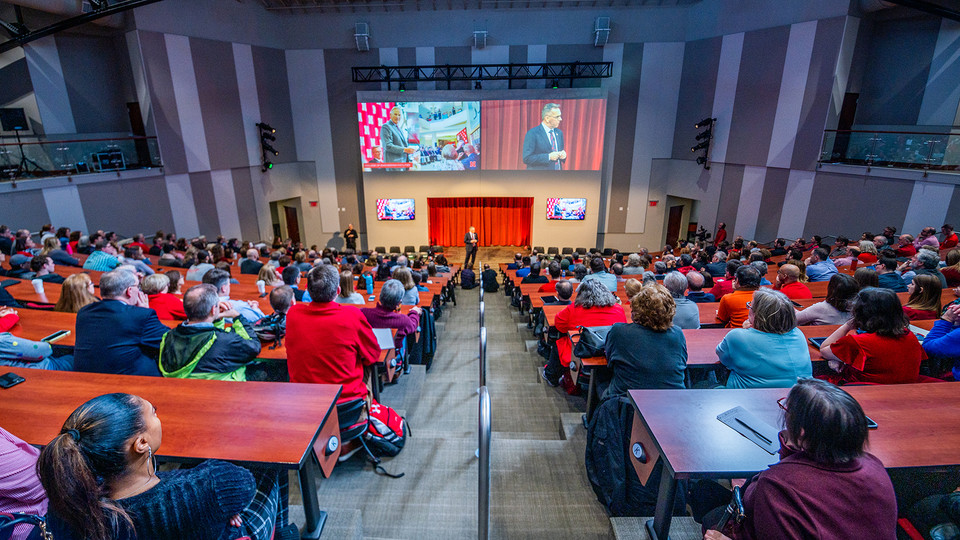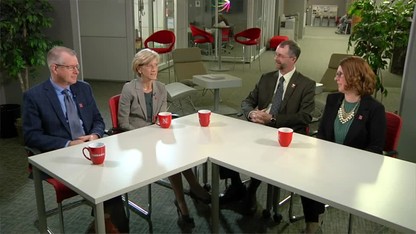· 4 min read
Strategic plan sets university’s course to 2025, beyond

A bold five-year strategic plan that calls for growth in graduation rates, research expenditures and hands-on, real-world experiences for all students is setting the foundation for a transformative 25-year blueprint at the University of Nebraska–Lincoln.
Outlined by Chancellor Ronnie Green during the State of Our University address on Feb. 14, the N2025 strategic plan is the first phase of a long-term visioning of what the institution should be like by its 175th year in 2044. Called for by Green, the visioning — completed by the N150 Commission, a group that included more than 150 stakeholders — was inspired by the university’s sesquicentennial celebration in 2019.
The plans were generated through an inclusive process, with input and guidance from students, faculty, staff and administrators.
“Nebraska and the world demands that we must be a bold, engaged, audacious, accessible and vibrant people’s university — student-centered, continually research-innovating and -developing, and never more outwardly reaching in our impacts to be Nebraska’s 21st-century people’s university,” Green said. “If we can’t invent, innovate and create at a university, where can we?”
From the N150 Commission visioning, the N2025 team elevated a repeated concept as a keystone to connect the university’s aspirations. That theme — that every person and every interaction matters — supports the aims, strategies, expectations and targets of the final N2025 strategic plan.
The six aims of the plan deal broadly with student success and learning, research excellence, creative activity, engagement, diversity and inclusion, and investing in students, faculty and staff. Those aims, each of which should be read to include the phrase “in a way that every person and every interaction matters,” are:
Innovate student experiences that prepare graduates to be lifelong learners and contributors to the workforce in Nebraska and the world;
Establish a culture at Nebraska committed to increasing the impact of research and creative activity;
Focus research, scholarship, creative activity and student experience to foster innovative, interdisciplinary endeavors and solve challenges critical to Nebraska and the world;
Broaden Nebraska’s engagement in community, industry and global partnerships;
Create a climate at Nebraska that emphasizes, prioritizes and expands inclusive excellence and diversity; and
Prioritize participation and professional development for all Nebraska students, staff and faculty.
Each aim includes a series of targets that — if achieved — will allow the university to continue building toward the 2044 vision of the N150 Commission.
Key student-centric targets in the plan include increasing graduation rates to 55% within four years of starting classes and to 72% by the six-year mark; boosting retention rates between first- and second-years of study to 88%; and, starting with the class of 2025 (which begins study in fall 2020), ensuring that all students participate in an experiential learning opportunity before graduation.
Additional targets set within the N2025 aims include:
Reaching $450 million in research expenditures;
Earning designation as a Carnegie Community Engagement Campus;
Aligning at least 50% of strategic investments with key state, national and global challenges, including water and food security, early childhood education and development, and climate change resiliency; and
Increasing the number and retention of students, faculty and staff from underrepresented groups — including a 7% increase in students from underrepresented ethnic/racial groups and an 8% expansion of enrollment among Pell-eligible, first-time-entering students.
The N2025 plan also outlines the need to create a long-term road map for university operations that ensures sustainability, environmental resilience and stewardship of natural resources.
The N2025 strategic team included 31 members of the campus community and was led by faculty members Rick Bevins, chair and professor of psychology; Shane Farritor, professor of mechanical and materials engineering; Angela Pannier, professor of biological systems engineering; and Sue Sheridan, director of the Nebraska Center for Research on Children, Youth, Families and Schools.
To keep the strategic plan moving forward, Green will assign a primary leader whose organization is accountable for each target. Lead organizations will provide guidance on the targets, marshalling a collaborative, universitywide effort to achieve related goals.
University leaders also plan to release progress reports to campus.
Complete reports from the N150 Commission and the N2025 strategic team are available for review online.









